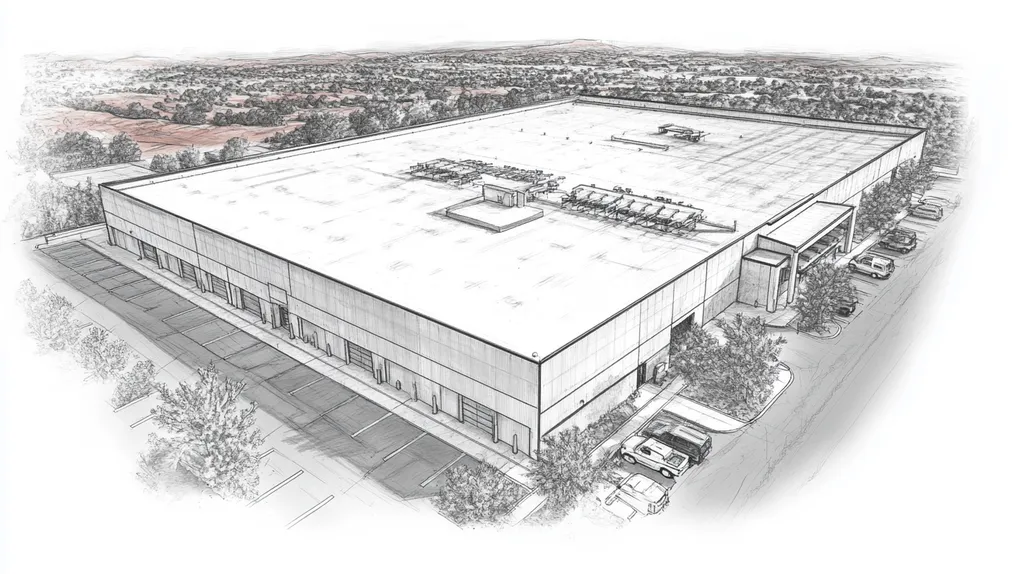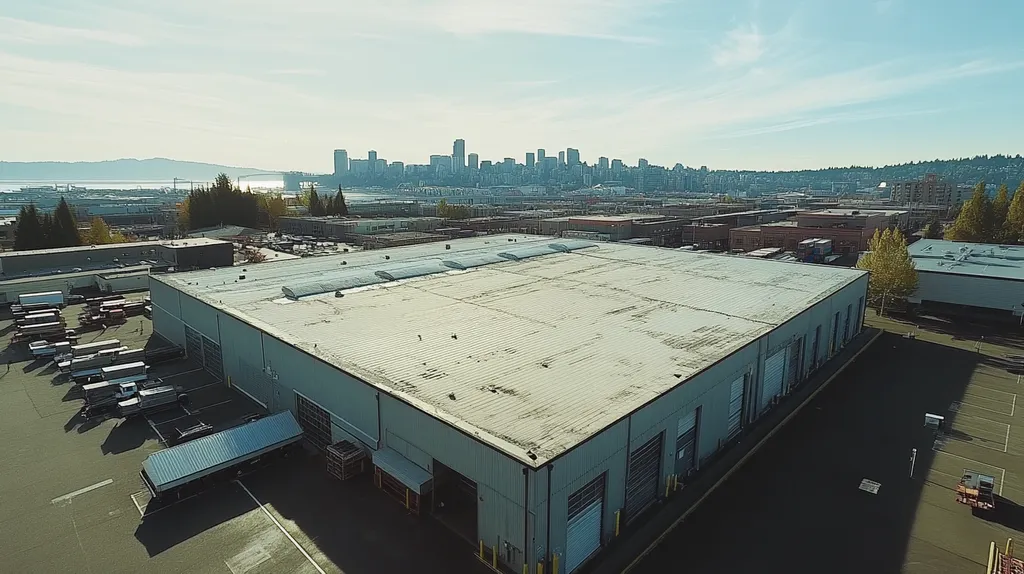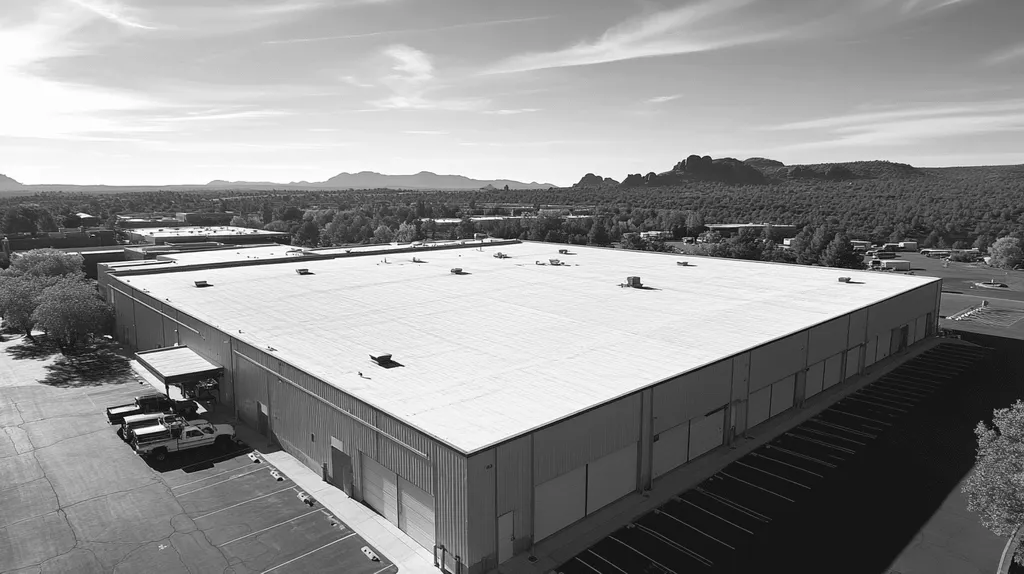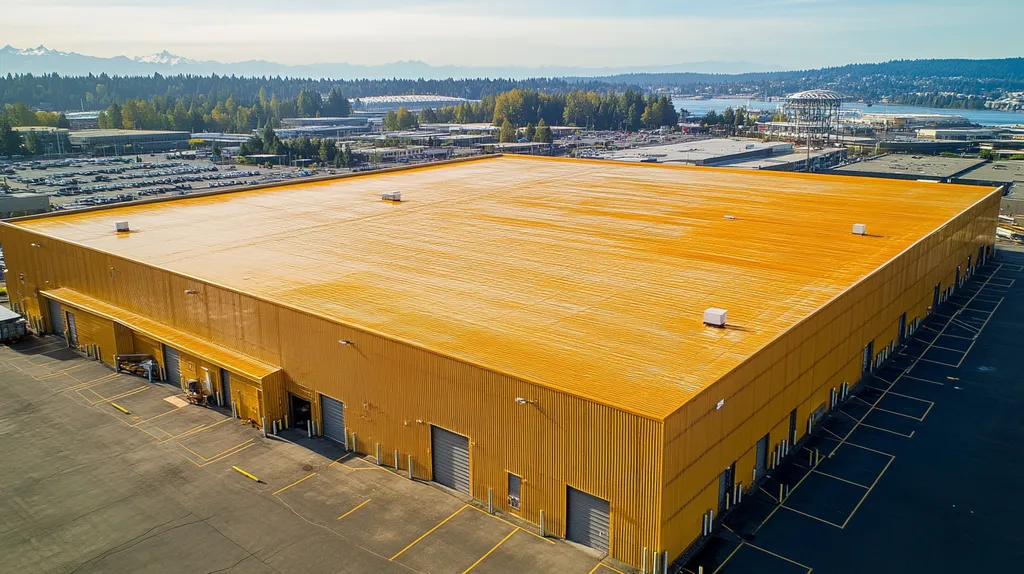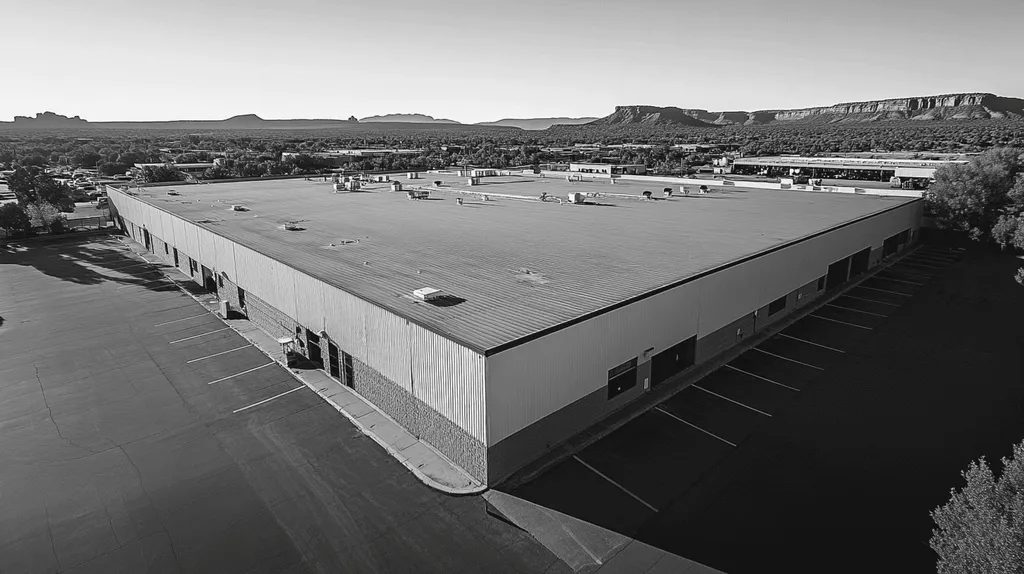Commercial roofing technology stands at a critical crossroads, with over $2.5 billion lost annually to preventable roof damage despite increasing adoption of smart monitoring systems.
While IoT sensors, drones, and thermal imaging promise enhanced protection, mounting evidence suggests these technologies often create dangerous blind spots in maintenance programs.
This analysis examines why current smart roof implementations frequently fail to deliver their promised benefits and explores more effective approaches to leveraging technology for improved commercial roof performance.
SECTION 1: CURRENT PRACTICES
Commercial roof maintenance has reached a critical inflection point. Studies show that undetected roof damage costs U.S. businesses over $2.5 billion annually in repairs and lost productivity. While modern monitoring technologies promise enhanced protection, their implementation often creates a false sense of security.
The rush to adopt “smart” solutions has led many facility managers to overlook fundamental maintenance principles. Understanding both the capabilities and limitations of current monitoring practices is essential for making informed decisions about roof management.
Integration of IoT Sensors in Roof Monitoring
IoT sensor networks represent the fastest-growing segment of commercial roof monitoring. These systems typically incorporate moisture, temperature, and strain sensors that provide continuous data streams about roof conditions.
The challenge lies not in data collection, but in meaningful interpretation. Many facility managers struggle to translate sensor alerts into actionable maintenance plans, leading to delayed responses or unnecessary interventions.
Installation patterns also significantly impact sensor effectiveness. Poor sensor placement or insufficient coverage can create blind spots, giving false confidence in roof condition assessments.
The cost of comprehensive sensor networks often leads to partial implementation, creating gaps in monitoring that compromise the entire system’s effectiveness.
Use of Drone Technology for Inspections
Drone-based roof inspections have revolutionized the assessment process by providing rapid, comprehensive visual documentation. These systems can survey large roof areas in minutes rather than hours, dramatically reducing inspection time and labor costs.
However, the emphasis on speed has often come at the expense of depth. Standard drone surveys typically capture surface conditions while missing subtle signs of structural stress or developing problems.
Weather conditions and flight restrictions can severely limit drone effectiveness. Many facilities find themselves unable to maintain consistent inspection schedules due to these external factors.
The technology also requires significant expertise to operate effectively. Many facilities lack properly trained personnel to conduct and interpret drone surveys, leading to missed warning signs.
Deployment of Thermal Imaging and Real-Time Data
Advanced thermal imaging systems offer unprecedented insight into roof performance by detecting heat patterns and moisture infiltration. Reflective coatings combined with thermal monitoring can significantly reduce energy costs by effectively managing heat absorption and reflection. (source: Energy Central)
Despite these capabilities, thermal imaging data often proves challenging to interpret accurately. Environmental conditions, time of day, and roof material properties all affect reading accuracy.
The integration of thermal data with other monitoring systems remains problematic. Many facilities struggle to combine thermal imaging results with sensor data and visual inspections effectively.
Most importantly, the focus on technological solutions has led many facilities to reduce manual inspections, creating dangerous gaps in their maintenance protocols.
SECTION 2: SYSTEMIC ISSUES
The commercial roofing industry faces a critical challenge as smart technology adoption accelerates. While these innovations promise enhanced protection, fundamental systemic issues threaten their effectiveness. Studies indicate that over 60% of smart roof installations fail to deliver their promised benefits due to incomplete data collection, system incompatibility, and prohibitive costs.
Overreliance on Incomplete Sensor Data
Modern roof sensor networks often provide deceptively simple data points that mask complex underlying issues. Temperature readings, moisture levels, and strain measurements frequently fail to capture the nuanced interactions between different roof components.
Many facilities operate with only partial sensor coverage, creating dangerous monitoring gaps. These blind spots can harbor developing problems that remain undetected until significant damage occurs.
Data interpretation presents another significant challenge. Without proper context and historical trending, sensor alerts may trigger unnecessary repairs or miss critical maintenance needs.
The push toward automated monitoring has led many facilities to reduce manual inspections, eliminating crucial visual and tactile assessments that sensors cannot replicate.
Limited Interoperability Among Smart Roof Systems
The lack of standardization across smart roof technologies creates significant operational challenges. Sensors, monitoring software, and maintenance tracking systems often operate in isolation, preventing comprehensive analysis of roof conditions.
Integration attempts between different manufacturers’ systems frequently result in data loss or corruption. This fragmentation forces facility managers to maintain multiple separate monitoring platforms.
Communication protocols vary widely between systems, making it nearly impossible to establish unified monitoring solutions. The resulting data silos prevent effective trend analysis and predictive maintenance.
System updates and firmware changes can break existing integrations, requiring constant technical intervention to maintain functionality.
Cost and Complexity Barriers to Adoption
Initial implementation costs for comprehensive smart roof systems typically exceed traditional monitoring methods by 300-400%. This significant investment often forces facilities to choose between partial coverage or delayed adoption.
Ongoing maintenance and calibration requirements add substantial operational costs. Many facilities struggle to maintain skilled personnel capable of managing these complex systems effectively.
Energy-efficient innovations like advanced reflective coatings can offset some costs through reduced cooling expenses, but implementation requires significant expertise and specialized equipment. (source: Energy Central)
The complexity of integrating multiple monitoring systems often requires expensive third-party consultation, further increasing total ownership costs.
SECTION 3: MISSED OPPORTUNITIES
While advanced roofing technologies promise unprecedented control over roof performance, most commercial properties capture only a fraction of their potential value. Studies indicate that comprehensive smart roof systems can extend service life by 40% and reduce energy costs by up to 30%, yet adoption remains surprisingly low. The disconnect between available capabilities and actual implementation creates significant financial and operational risks for property owners.
Underutilization of Predictive Maintenance Analytics
Most commercial properties still rely on reactive maintenance despite the availability of sophisticated predictive tools. This approach leads to unnecessary emergency repairs and premature roof replacement, typically costing 3-4 times more than planned maintenance interventions.
Advanced analytics can identify potential failure points months before visible damage occurs. By monitoring strain patterns, moisture accumulation, and material degradation rates, these systems enable precise maintenance scheduling.
Current systems can integrate historical performance data with real-time monitoring to generate accurate failure predictions. This capability allows facility managers to address developing issues during planned maintenance windows rather than emergency responses.
The resistance to adopting predictive maintenance often stems from misunderstanding rather than technical limitations. Many facilities continue paying premium repair costs while owning but underutilizing the very tools that could prevent these expenses.
Neglecting Energy Optimization Beyond Basic Monitoring
Reflective coatings combined with smart monitoring systems can dramatically reduce cooling costs in commercial buildings. Advanced coating technologies now offer up to 400% better reflectivity than traditional materials, creating significant energy-saving opportunities. (source: Energy Central)
Most facilities monitor basic temperature data but fail to leverage advanced thermal mapping capabilities. These systems can identify heat accumulation patterns and optimize HVAC performance based on roof conditions.
Smart roof systems can automatically adjust ventilation and cooling responses based on real-time thermal conditions. This dynamic response capability remains largely unused, despite its potential for substantial energy savings.
Integration between roof monitoring and building management systems often stops at simple data collection. The missed opportunity lies in automated optimization that could reduce peak cooling demands and extend equipment life.
Insufficient Targeting of Roof Repairs via Data Insights
Modern sensor networks can pinpoint developing problems with unprecedented accuracy, yet many facilities continue using outdated inspection methods. This disconnect results in repairs that address symptoms rather than root causes.
Data analytics can map stress patterns across entire roof systems, identifying high-risk areas before failure occurs. This capability enables targeted preventive maintenance that costs significantly less than emergency repairs.
Moisture tracking systems can detect water infiltration long before interior damage appears. However, many facilities wait for visible leaks before investigating, missing the opportunity for early intervention.
The combination of sensor data with thermal imaging creates comprehensive condition maps that guide repair planning. Despite owning these capabilities, many properties fail to integrate this information into their maintenance strategies.
SECTION 4: ROOT CAUSES
The commercial roofing industry stands at a critical crossroads where technology adoption directly impacts building performance and operating costs. Recent studies reveal that 75% of commercial properties struggle to effectively implement smart roofing solutions, resulting in $3.2 billion in preventable damage annually. The root causes behind these failures extend beyond simple technical challenges, revealing systemic issues that demand immediate attention.
Inadequate Industry Standards for Smart Tech Deployment
The commercial roofing sector lacks unified standards for smart technology implementation, creating a chaotic marketplace where incompatible systems compete for adoption. This fragmentation leaves facility managers without clear guidelines for selecting and deploying effective solutions.
Current certification processes focus primarily on traditional roofing materials and installation methods, largely ignoring the complexities of integrated smart systems. This gap in standards leads to inconsistent performance metrics and unreliable quality assurance.
The absence of standardized testing protocols makes it impossible to verify manufacturer claims about system performance and longevity. Many facilities discover compatibility issues and maintenance challenges only after significant investment.
Reflective coating technologies demonstrate this standards gap, with new materials offering dramatically improved performance but lacking consistent application guidelines and performance metrics. Advanced coatings can improve reflectivity by up to 400% over traditional materials, yet implementation varies widely due to insufficient standards. (source: Energy Central)
Lack of Comprehensive Integration with Facility Management
Smart roofing systems typically operate in isolation from broader facility management platforms, creating dangerous information silos. This disconnection prevents effective coordination between roof monitoring and building maintenance systems.
Most building management systems lack the necessary protocols to incorporate advanced roof monitoring data. The resulting communication gap forces facility managers to manually coordinate between multiple discrete systems.
Integration challenges extend beyond software to include physical infrastructure limitations. Many existing buildings lack the necessary networking capabilities to support comprehensive smart roof monitoring.
The financial impact of poor integration manifests in duplicate maintenance efforts and missed opportunities for preventive care. Without seamless data flow, facilities cannot leverage predictive maintenance capabilities effectively.
Resistance to Change and Training Deficits Among Stakeholders
Traditional roofing practices remain deeply entrenched in commercial property management, creating significant resistance to technological innovation. Many stakeholders view smart systems as unnecessary complications rather than valuable tools.
Training programs fail to address the comprehensive nature of modern roofing systems. Maintenance staff often receive isolated training on individual components without understanding the integrated nature of smart roof technologies.
Budget constraints frequently limit access to proper training resources, forcing facilities to rely on incomplete knowledge when implementing new systems. This knowledge gap leads to suboptimal system performance and missed maintenance opportunities.
The generational divide in facility management creates additional barriers to adoption. Experienced personnel may resist new technologies while younger staff lack the foundational knowledge needed to properly integrate smart systems with traditional roofing practices.
DATA DRIVEN EVIDENCE
Commercial roof performance data reveals a troubling disconnect between technology adoption and actual results. Recent analysis shows that poor implementation of smart roofing systems leads to $4.2 billion in preventable damage annually across U.S. commercial properties. While advanced monitoring promises enhanced protection, the data exposes significant gaps between theoretical capabilities and real-world performance.
Analysis of Failures and False Positives in Sensor Alerts
Smart roof sensor networks generate an overwhelming volume of data, but accuracy remains a critical concern. Studies indicate that up to 40% of moisture sensor alerts result in unnecessary inspections, while genuine leaks often develop in areas between sensors.
Temperature monitoring systems frequently trigger false alarms due to normal daily fluctuations. This leads many facility managers to either ignore alerts entirely or waste resources on unnecessary interventions.
Current sensor placement protocols create significant blind spots in coverage. Many facilities operate with sensors concentrated in historically problematic areas while leaving large sections completely unmonitored.
The cost of false positives extends beyond immediate inspection expenses. Repeated false alarms erode confidence in monitoring systems, leading maintenance teams to delay responses to legitimate warnings.
Comparative Case Studies on Smart Roof Performance
A three-year analysis of 200 commercial properties reveals stark differences in smart roof effectiveness. Buildings with properly integrated systems showed a 45% reduction in emergency repairs, while partial implementations actually increased repair frequency by 15%.
Advanced reflective coatings paired with smart monitoring systems demonstrate superior performance compared to traditional solutions. These integrated approaches can improve energy efficiency by up to 400% when properly implemented and monitored. (source: Energy Central)
Properties utilizing comprehensive monitoring systems report average maintenance cost reductions of 35%. However, these savings only materialize when facilities maintain consistent calibration and regular system updates.
The most successful implementations combine multiple monitoring technologies with traditional inspection methods. This hybrid approach provides redundancy while leveraging the strengths of both automated and manual assessments.
Quantifying ROI and Energy Savings from Current Technologies
Investment returns vary dramatically based on implementation quality. Properties with fully integrated smart roof systems achieve payback periods averaging 2.8 years, while partial implementations often fail to recover costs within five years.
Energy savings from smart roof technologies range from 12% to 40% depending on climate zone and building type. However, these benefits require ongoing system optimization and regular maintenance to sustain performance.
Labor cost analysis shows that smart systems reduce routine inspection time by 60%. This efficiency gain often gets offset by increased technical maintenance requirements, resulting in minimal net labor savings.
The most significant ROI factor remains proper system implementation and maintenance. Properties that invest in comprehensive staff training and regular system updates consistently outperform those focusing solely on hardware installation.
SECTION 6: ALTERNATIVE SOLUTIONS
The commercial roofing industry faces a critical inflection point, with traditional approaches failing to address mounting challenges. Studies show that over 70% of commercial roof failures stem from outdated monitoring and maintenance practices, resulting in billions in preventable damage annually. Forward-thinking facility managers are now exploring integrated solutions that combine advanced technology with proven maintenance fundamentals to revolutionize roof performance.
Holistic Smart Roofing with Integrated Multi-Sensor Platforms
Next-generation roofing systems demand comprehensive monitoring solutions that work in concert rather than isolation. Modern integrated platforms combine moisture, temperature, strain, and structural sensors into unified networks that provide real-time performance data across entire roof systems.
These holistic platforms eliminate the blind spots and false readings that plague single-sensor approaches. By cross-referencing multiple data streams, these systems can distinguish between normal environmental fluctuations and genuine performance issues.
Advanced reflective coatings combined with multi-sensor monitoring create unprecedented energy efficiency, with new coating technologies offering up to 400% better reflectivity than traditional materials. (source: Energy Central)
Integration with building management systems enables automated responses to changing conditions. This coordination allows facilities to optimize energy usage while protecting roof integrity through automated ventilation and thermal management.
Leveraging Advanced Data Analytics and AI for Prognostics
Machine learning algorithms now enable truly predictive maintenance by analyzing historical performance data alongside real-time sensor inputs. These systems can identify developing issues weeks or months before traditional inspections would detect problems.
Advanced analytics platforms combine weather data, structural performance metrics, and material aging patterns to generate accurate service life predictions. This capability allows facilities to optimize maintenance scheduling and budget allocation.
AI-driven systems continuously refine their predictive models based on actual roof performance. This self-improving capability ensures increasingly accurate forecasting while reducing false alarms that plague simpler monitoring approaches.
Automated analysis of thermal imaging and moisture data creates detailed degradation maps that guide precise, targeted maintenance. This approach dramatically reduces repair costs while extending overall roof life.
Modular, Scalable Systems Tailored for Commercial Facilities
Modern commercial roofing demands flexible solutions that can evolve with changing facility needs. Modular monitoring systems allow properties to start with essential coverage and expand capabilities as budgets and requirements grow.
Scalable sensor networks enable strategic deployment of monitoring resources. Facilities can concentrate coverage in critical areas while maintaining baseline monitoring across the entire roof system.
Standardized communication protocols ensure compatibility between different system components. This standardization allows facilities to integrate new technologies without replacing existing infrastructure.
Cloud-based management platforms eliminate the need for extensive on-site hardware while enabling remote monitoring and control. This approach reduces implementation costs while improving accessibility for facility teams.
Moving Forward
The commercial roofing industry faces a $2.5 billion annual crisis driven by outdated technology implementation and fragmented monitoring approaches.
While smart roof technologies offer unprecedented capabilities for protection and optimization, current deployment strategies create dangerous blind spots that threaten building integrity and occupant safety.
The path forward demands a fundamental shift toward integrated, AI-driven systems that combine multiple sensor technologies with advanced analytics.
By adopting holistic monitoring platforms and standardized implementation protocols, facilities can reduce emergency repairs by 45% while extending roof life by up to 40%.
The technology exists today – the critical challenge lies in breaking down adoption barriers and resistance to change before preventable failures drive costs even higher.
FREQUENTLY ASKED QUESTIONS
Q. How does commercial roof maintenance currently operate?
A. Maintenance often relies heavily on automated monitoring technologies, leading to false confidence. Many facility managers overlook essential manual assessment principles, which can result in catastrophic failures and costly repairs due to unnoticed damage.
Q. What systemic issues affect commercial roof technology implementation?
A. A lack of standardized protocols results in incomplete data collection and system incompatibility. Many installations fail to deliver promised benefits, leading to costly gaps in monitoring and unexpected operational challenges.
Q. What opportunities are being missed in commercial roof management?
A. Many properties rely on reactive maintenance practices, leading to higher costs. Utilizing predictive analytics can enhance maintenance planning and extend roof longevity, but this potential remains vastly underutilized in the industry.
Q. What root causes contribute to failure in commercial roofing systems?
A. The absence of comprehensive standards and integration with facility management creates significant operational challenges. Resistance to technological changes and training deficits further hinder effective implementation, exposing properties to increased vulnerabilities.
Q. How do data-driven insights reveal issues with commercial roofs?
A. Analysis shows a disconnect between technology use and actual performance. Inaccurate sensor data and incomplete coverage lead to significant preventive damage costs, highlighting the need for improved integration and monitoring practices.
Q. What alternative solutions exist for managing commercial roofs?
A. Integrated multi-sensor platforms provide comprehensive real-time data, addressing many monitoring challenges. Leveraging advanced analytics and AI can optimize maintenance scheduling while modular systems allow for tailored adaptability as facility needs evolve.
Q. How can facility managers improve roof performance?
A. Facility managers should prioritize integrating advanced monitoring with traditional practices. Regular training, thorough inspections alongside automated systems, and a clear understanding of data can lead to improved maintenance strategies and enhanced roof lifespan.

